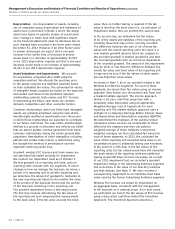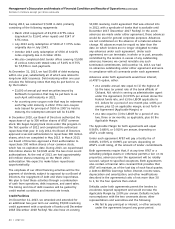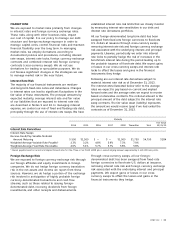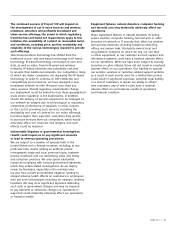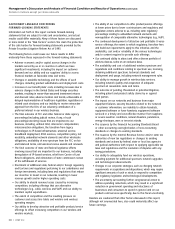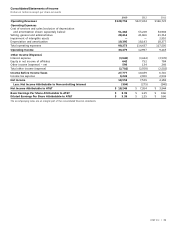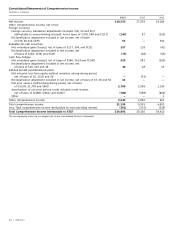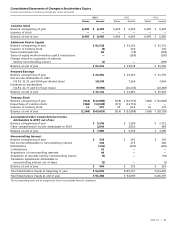AT&T Wireless 2013 Annual Report Download - page 38
Download and view the complete annual report
Please find page 38 of the 2013 AT&T Wireless annual report below. You can navigate through the pages in the report by either clicking on the pages listed below, or by using the keyword search tool below to find specific information within the annual report.
Management’s Discussion and Analysis of Financial Condition and Results of Operations (continued)
Dollars in millions except per share amounts
36 | AT&T Inc.
Increasing competition for wireless customers could
adversely affect our operating results.
We have multiple wireless competitors in each of our
service areas and compete for customers based principally
on service/device offerings, price, call quality, coverage
area and customer service. In addition, we are facing
growing competition from providers offering services using
alternative wireless technologies and IP-based networks
as well as traditional wireline networks. We expect market
saturation to continue to cause the wireless industry’s
customer growth rate to moderate in comparison with
historical growth rates, leading to increased competition
for customers. We also expect that our customers’ growing
demand for data services will place constraints on our
network capacity. This competition and our capacity issues
will continue to put pressure on pricing and margins as
companies compete for potential customers. Our ability
to respond will depend, among other things, on continued
improvement in network quality and customer service
and effective marketing of attractive products and services,
and cost management. These efforts will involve significant
expenses and require strategic management decisions on,
and timely implementation of, equipment choices, network
deployment and management, and service offerings.
Increasing costs in our wireline operations could
adversely affect wireline operating margins.
We expect our operating costs, including customer
acquisition and retention costs will continue to put
pressure on pricing, margins and customer retention
levels. A number of our competitors that rely on alternative
technologies (e.g., wireless, cable and VoIP) and business
models (e.g., advertising-supported) are typically subject
to less (or no) regulation than our wireline subsidiaries
and therefore are able to operate with lower costs.
These competitors also have cost advantages compared
to us, due in part to operating on newer, more technically
advanced and lower-cost networks and a nonunionized
workforce, lower employee benefits and fewer retirees
(as most of the competitors are relatively new companies).
Over time these cost disparities could require us to evaluate
the strategic worth of various wireline operations. To this
end, we have begun initiatives at both the state and federal
levels to obtain regulatory approvals, where needed, to
transition services from our older copper-based network
to an advanced IP-based network. If we do not obtain
regulatory approvals for this transition or obtain approvals
with onerous conditions attached, we could experience
significant cost and competitive disadvantages.
our networks and recover costs and lessen incentives
to invest in our networks. The development of new
technologies, such as IP-based services, also has created
or potentially could create conflicting regulation between
the FCC and various state and local authorities, which may
involve lengthy litigation to resolve and may result in
outcomes unfavorable to us. In addition, increased public
focus on a variety of issues related to our operations,
such as privacy issues, government requests or orders
for customer data, and potential global climate changes,
have led to proposals at state, federal and foreign
government levels to change or increase regulation on
our operations. Should customers decide that our
competitors operate in a more customer-friendly
environment, we could be materially adversely affected.
Continuing growth in our wireless services will depend
on continuing access to adequate spectrum, deployment
of new technology and offering attractive services to
customers.
The wireless industry is undergoing rapid and significant
technological changes and a dramatic increase in usage,
in particular demand for and usage of data, video and
other non-voice services. We must continually invest in
our wireless network in order to continually improve our
wireless service to meet this increasing demand and remain
competitive. Improvements in our service depend on many
factors, including continued access to and deployment of
adequate spectrum. We must maintain and expand our
network capacity and coverage as well as the associated
wireline network needed to transport voice and data
between cell sites. To this end, we continue to deploy
technology advancements in order to further improve
network quality and the efficient use of our spectrum.
Network service enhancements and product launches
may not occur as scheduled or at the cost expected due
to many factors, including delays in determining equipment
and handset operating standards, supplier delays, increases
in network equipment and handset component costs,
regulatory permitting delays for tower sites or enhancements
or labor-related delays. Deployment of new technology also
may adversely affect the performance of the network for
existing services. If the FCC does not fairly allocate sufficient
spectrum to allow the wireless industry in general, and the
Company in particular, to increase its capacity or if we
cannot acquire needed spectrum or deploy the services
customers desire on a timely basis without burdensome
conditions or at adequate cost while maintaining network
quality levels, then our ability to attract and retain customers,
and therefore maintain and improve our operating margins,
could be materially adversely affected.


